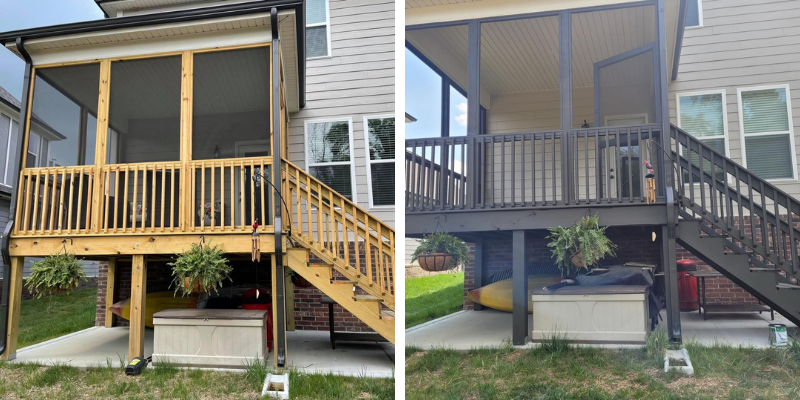Deck Staining & Painting Company in Middle Tennessee
Like a lot of our friends and neighbors here in the Nashville area, you likely have a backyard deck. These outdoor spaces are the perfect spot to spend time with family and friends, soak up some sun, or unwind in the cool of the evening after a busy day.
Decks don’t ask for much in return: just some basic care and maintenance. Taking these precautionary steps, however, pays massive dividends. Ignoring your deck in Nashville leads to premature rot, UV damage, and decay, while routine maintenance will help ensure your favorite outdoor space is ready to enjoy for years to come.
A healthy coating of paint or stain is your deck’s first line of defense, and offers major aesthetic benefits as well. Here at Nash Painting, we have extensive deck staining experience, and have a systematic approach that works every time and performs to our standards. Like all of our painting and finishing services, we focus on offering the best value possible: no cut corners or quick fixes.
Should I paint or stain my deck?
There are pros and cons to both approaches, but one major takeaway might help you make your decision.
Paint sits on top of the wood, meaning that it can be applied quickly, looks good, and hides blemishes, but it will fail over time as your deck’s wood naturally expands and contracts. If applied well, paint will last quite a while, but it doesn’t offer the same level of surface saturation that stain does.
Also, a lot of homeowners prefer the more natural wood look that stain offers. If that doesn’t matter to you, paint might be the way to go. On the other hand, if you love the character and charm of wood, and don’t mind refreshing your deck stain every couple of years, a natural finish would be the better option.
Put your budget, willingness to invest in maintenance, and aesthetic preferences on the scale before you commit to a finish. Also, you can talk to us at Nash Painting. After reviewing your specific deck and sharing some options, the right path might become clearer.
Understanding our deck painting process
As we touched on above, we take deck staining in Nashville very seriously. We have a process that’s tried-and-true, and while it’s labor intensive and detailed, you can rest easy knowing that the job was done right. This yields a better looking finish, better protection for your surface, and a better return on your investment.
Here’s what it looks like:
We begin with a thorough power washing to remove dirt, flaking sealer, moss, mildew, and algae.
The Sherwin-Williams’ Deckscapes product we use has built-in sealer, making only one coat necessary in most cases. If your deck is either brand new or severely weathered, we may need to apply a second coat.
We work systematically across your deck to ensure even coverage, working the stain into the surface with brushes.
Why choose Nash Painting?
We offer a no-hassle deck staining experience. You can count on a detailed proposal too that clearly outlines the job scope, products, and associated cost.
We have over 15 years of residential deck painting and staining experience.
We meet our deadlines, every time.
Our costs are competitive, and our value is unparalleled.
Our skilled team can handle any deck staining project you have in mind, and can help you make the best product choices for your specific needs.
Deck staining FAQ

Q. When is it time to re-stain my deck?
We recommend refinishing your deck every 2-3 years. If you aren’t sure when the deck was last finished (if you just moved into your home, for example), look at the surface condition of the wood. If it’s faded or flaking, it’s definitely time to refinish.
Q. What colors should I stain or paint my deck?
First decide if you want to stain or paint (there are benefits to each). If you stain, let your deck’s current condition guide you toward the right finish type. You can select a more solid deck stain that will hide, or minimize, surface imperfections, or choose a more transparent stain that offers less protection but allows your wood to really shine.
Q. What’s the best season for deck staining?
You may think spring or fall is ideal, but those typically cooler nights combined with higher humidity from rainfall drastically slow down the curing process. In turn, this means the surface will remain tacky for weeks (in some cases). Also, the deck boards eventually release trapped moisture causing the stain to peel, sometimes within a year. With these considerations in mind, summer is actually the best time to seal a deck.
Q. Can you paint over old deck paint?
Yes, absolutely. Just bear in mind that you’ll need to carefully prepare the surface, just as you would for any other exterior painting project. Clean, repair where needed, prime, and paint.
Q. How long does painting or staining a deck take?
It depends on a number of variables: the size of the deck, scope of the work, products being used, etc. In general, the project can take from 1-3 days, on average.



















































